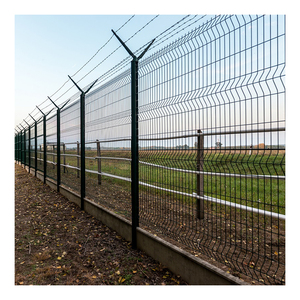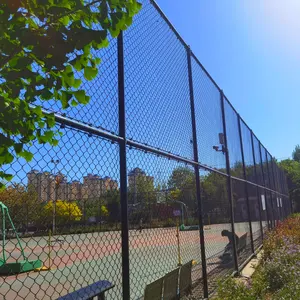(46929 products available)
































































































































































































A mesh fence post is a vertical support structure used in mesh fencing systems. These posts provide stability and strength to hold the fence panels in place. Mesh fencing is commonly used for security, containment, and protection in residential, commercial, and industrial settings. Here are some key points about mesh fence posts:
There are different types of mesh fence posts designed for various applications and environments. Some common types include:
Each type of mesh fence post is designed to meet specific needs and performance requirements, ensuring the fence provides security and durability for its intended purpose.
The top rail post:
This type of fence post has a rail attached to the top of the post. The wire mesh is then attached to the sides of the post. This style is popular for chain link fence gates and other mesh fence openings. It is more stable than the others.
The line post:
As the name implies, the line post is placed at intervals along the fence. It serves as a support for the fence mesh. It is also most commonly used and easy to install. The line post can come in different sizes and shapes, including round, square, and rectangular. When installing a mesh fence that requires a lot of cutting and adapting to specific areas, the line post is the best choice.
The corner post:
Just like the name indicates, the corner post is placed at the corner of the mesh fence. It supports the direction change of the fence. It is more durable than the others because it has to support two sides of the mesh fence. When installing a fence that will last for years, the corner post is the best option to go for.
The end post:
The end post is placed at the end of the mesh fence. It is similar to the line post except that the line post is placed at the end and the line post in between. The end post is usually more stable than the line post because it has to support the tension of the entire fence. For this reason, the end post is typically larger than the line post.
The break post:
The break post is placed at intervals along the mesh fence, just like the line post. The only difference is that the break post is larger and more visible than the line post. It serves as a support for the fence and indicates where the fence can be broken.
Industrial Areas:
Chain link fence posts are used to fence in factories, warehouses, and other industrial places. The fences keep workers safe by keeping out animals and people, and they secure the area by preventing access to restricted zones.
Agricultural Use:
Farm mesh fence posts are used to protect crops and livestock. Fences keep animals from eating plants and make sure cows, sheep, and chickens stay inside. Farmers use these fences to stop wild animals from damaging their fields and to keep all their animals safe in the farm area.
Construction Sites:
During building projects, temporary mesh fences are put around the site. This keeps people safe by preventing them from walking into the work area. It also stops tools and materials from being taken. The fence serves as a barrier to protect everything while the construction is going on.
Residential Properties:
Homeowners use mesh fence posts for privacy and security. These fences can enclose yards, gardens, and pools. They keep kids and pets safe at home and stop strangers from entering. With fences, people can also have more privacy in their own outdoor spaces.
Sports Facilities:
In places where sports are played, mesh fences are used as barriers. In ball fields and courts, fences keep balls from going out of bounds. At tennis courts and basketball areas, netting can be used to catch balls and allow for quick retrieval. Fences also separate different playing areas.
Public Parks and Recreation Areas:
In parks and public spaces, fence posts are used to outline trails, gardens, and picnic spots. This helps direct visitors and preserves the natural environment. Fences can also section off play areas for kids and keep them safe while they enjoy the playground equipment.
Wildlife Protection:
Mesh fencing is used in wildlife conservation areas and zoos. This fencing separates different animal habitats and keeps wild animals from leaving their designated zones. It also protects animals from interacting with people.
Wholesale buyers of mesh fence posts need to evaluate the manufacturers and suppliers carefully. Here are some critical factors to consider when choosing a supplier of mesh fence posts:
Product Quality and Standards:
Ensure that the mesh fence posts meet relevant quality and safety standards. Look for posts that have passed tests for durability, strength, and corrosion resistance. Ask suppliers for product certifications and test reports to verify quality.
Supplier Reputation:
Choose suppliers with a positive reputation in the industry. Check their history, customer reviews, and feedback from other buyers. Consider suppliers who have a track record of delivering good products on time and providing excellent customer service.
Customization and Product Range:
Look for suppliers who offer customization and a wide range of mesh fence post products. The supplier should be able to customize fence posts to meet specific project needs. Also, the supplier should have different types, materials, and sizes of mesh fence posts for choice.
Supply Chain and Logistics:
Evaluate the supplier's supply chain and logistics capabilities. Ensure that they can deliver products on time to meet project deadlines. Ask about their inventory management and shipping processes to ensure a smooth supply chain.
Cost and Pricing:
Compare the costs of mesh fence posts among different suppliers. Consider the pricing structure and any discounts for bulk orders. However, do not sacrifice quality for a low price. Balance cost and quality to achieve the best value for money.
Warranty and After-sales Service:
Check the warranty and after-sales service provided by the supplier. Make sure they offer a reasonable warranty period for product defects. Understand their after-sales support and return policies to resolve any issues that may arise.
Communication and Collaboration:
Effective communication is vital for a successful partnership. Choose a supplier who responds promptly to inquiries and communicates clearly. Build a collaborative relationship with the supplier to ensure smooth cooperation.
Sustainability and Environmental Considerations:
Pay attention to the sustainability and environmental practices of the supplier. Choose suppliers who use eco-friendly materials and follow sustainable production practices. With the rise of eco-conscious consumers, environmental responsibility is becoming a crucial factor in purchasing decisions.
Q1: What are the advantages of using mesh fence posts over traditional wooden fence posts?
A1: Mesh fence posts typically offer better durability, maintenance, and cost-effectiveness in the long run. Unlike wooden posts, mesh fence posts are not prone to issues like rot, warping, or termite damage. They can also withstand harsh weather conditions better than wood. As a result, mesh fence posts can last many years, providing a more economical choice over time.
Q2: How can one ensure the proper installation of a mesh fence with its posts?
A2: To guarantee the correct installation of a mesh fence post, one must ensure that the hole for the fence post is dug deep enough to accommodate at least one-third of the post's total length. Additionally, aligning the posts vertically and securing them with gravel or concrete around their bases is essential.
Q3: Are mesh fence posts environmentally friendly?
A3: Many mesh fence posts, especially those made from recycled materials, can be environmentally friendly. Moreover, fences like these usually have a lower effect on habitats and wildlife compared to walls made of solid structures.